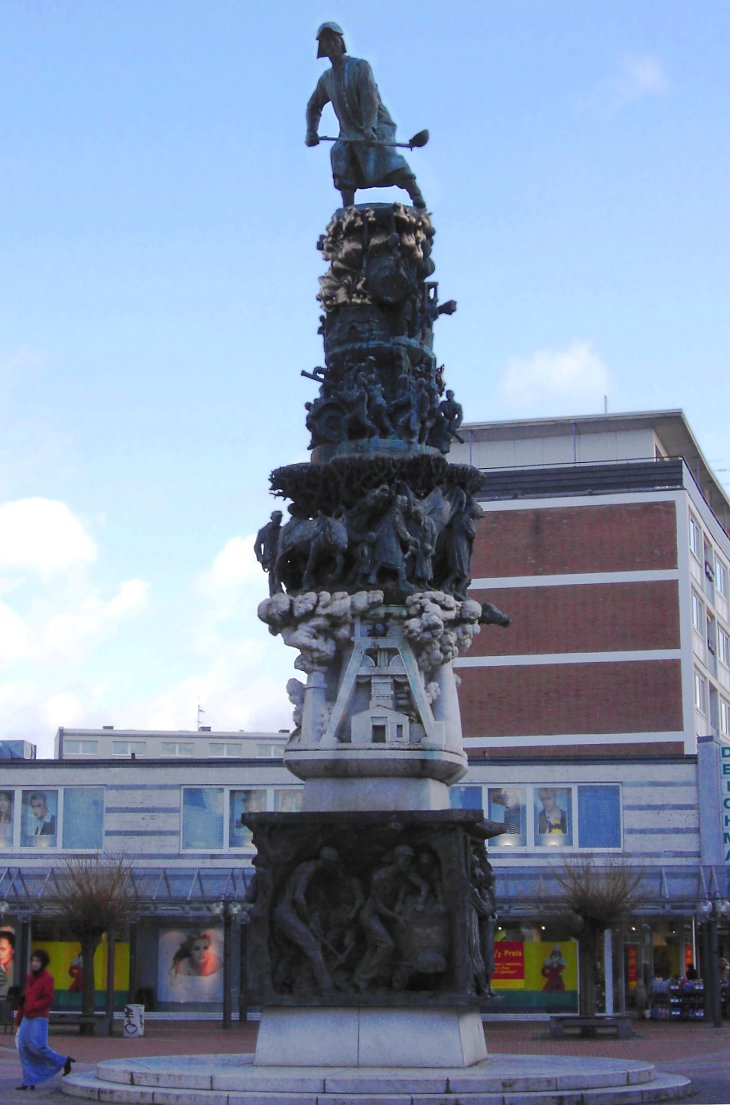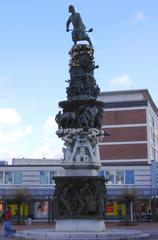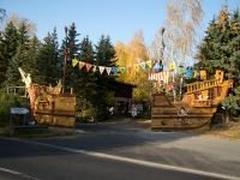
Comprehensive Guide to Visiting Turm der Arbeit, Heere, Germany
Date: 01/08/2024
Introduction
The ‘Turm der Arbeit’ (Tower of Labor) stands as a monumental sculpture in the pedestrian zone of Salzgitter-Lebenstedt, Germany, and is one of the region’s most iconic landmarks. Conceived by the artist Jürgen Weber and unveiled in 1995, this impressive structure serves not only as a historical marker but also as a cultural symbol that reflects the area’s rich industrial heritage and tumultuous history. Constructed over a decade from 1985 to 1995, the monument was unveiled to coincide with Salzgitter’s 50th anniversary, highlighting its significance (The Crazy Tourist). Standing at 13.73 meters high and weighing 36.5 tons, the ‘Turm der Arbeit’ is made from marble and bronze, with a foundation extending 1.2 meters deep. It cost 1,130,000 Deutsche Mark (DM) to build, a testament to its monumental nature. This guide aims to provide a comprehensive overview of the monument’s history, cultural significance, and practical information for visitors, ensuring a well-rounded and enriching experience for those who come to explore this powerful symbol of Salzgitter’s past and resilience.
Table of Contents
- Introduction
- Historical Background
- Visitor Information
- Travel Tips
- Cultural Significance
- Visitor Experience
- FAQ
- Conclusion
Historical Background
Creation and Inception
The ‘Turm der Arbeit’ was constructed between 1989 and 1995, commissioned in 1985, and unveiled in 1995 to coincide with Salzgitter’s 50th anniversary in 1992. The creation spanned a decade, highlighting the project’s complexity and significance.
Physical Characteristics
Standing at 13.73 meters and weighing 36.5 tons, the sculpture has a foundation extending 1.2 meters deep, ensuring stability. Made from marble and bronze, the monument cost 1,130,000 Deutsche Mark (DM).
Symbolism and Themes
The sculpture serves as a poignant reminder of Salzgitter’s tumultuous history, reflecting themes such as forced labor during the Nazi era and post-war reconstruction. It features four reliefs: ‘Arbeit unter Tage’ (Work Underground), ‘Eintreibung von Arbeitern’ (Rounding Up of Workers), ‘Sabotage,’ and ‘Karitas’ (Charity).
Historical Context
Erected during Germany’s period of reflection and change in the late 20th century, the monument’s creation coincided with the end of the Cold War and the reunification of Germany, adding layers of meaning to its symbolism.
Visitor Information
Visiting Hours and Tickets
While the ‘Turm der Arbeit’ itself is accessible at all times, guided tours and informational sessions may have specific hours. It is advisable to check local resources or the visitor center for the most up-to-date information on hours and any potential fees.
Accessibility
Located in the pedestrian zone of Salzgitter-Lebenstedt, the monument is easily accessible. The area is well-equipped for visitors with mobility needs, ensuring everyone can appreciate this significant landmark.
Travel Tips
Best Time to Visit
The monument can be visited year-round, but spring and summer offer the most pleasant weather for exploring the pedestrian zone.
Nearby Attractions
Salzgitter-Lebenstedt offers various shops, cafes, and other attractions. Visitors can spend a leisurely day exploring the area, making the most of both the monument and the surrounding amenities.
Special Events
Keep an eye out for special events and public gatherings that often take place around the monument, adding a dynamic element to your visit.
Cultural Significance
The ‘Turm der Arbeit’ embodies the spirit and resilience of Salzgitter, serving as a testament to the city’s ability to overcome adversity. It is a focal point for community gatherings and public events, reinforcing its role as a symbol of unity and collective memory.
Visitor Experience
The detailed reliefs and towering presence invite contemplation on themes of labor, struggle, and resilience. Informational plaques and guided tours enhance the experience, providing deeper insight into the monument’s significance.
FAQ
What are Turm der Arbeit’s visiting hours?
The monument itself is accessible at all times, but guided tours may have specific hours. Check local resources for details.
How much do Turm der Arbeit tickets cost?
There is no admission fee to visit the monument, but guided tours may have a nominal charge.
Is the monument accessible?
Yes, the pedestrian zone is well-equipped for visitors with mobility needs.
Conclusion
The ‘Turm der Arbeit’ is a powerful symbol of Salzgitter’s history and resilience. Its creation marked significant events in the city’s and Germany’s history. For visitors, the monument offers a unique and meaningful experience, providing insight into the city’s past and its enduring spirit. Be sure to explore the surrounding area for a comprehensive visit. Stay updated with the latest information, and enjoy your trip to this historic landmark.
References
- The Crazy Tourist. (n.d.). 15 Best Things to Do in Salzgitter (Germany). Retrieved from The Crazy Tourist
- Travellers Worldwide. (n.d.). Best Time to Visit Germany. Retrieved from Travellers Worldwide
- Deutsche Bahn. (n.d.). Train Schedules and Ticket Bookings. Retrieved from Deutsche Bahn
- My Germany Vacation. (n.d.). 10 Days in Germany Itinerary Ideas for the Perfect Trip. Retrieved from My Germany Vacation







